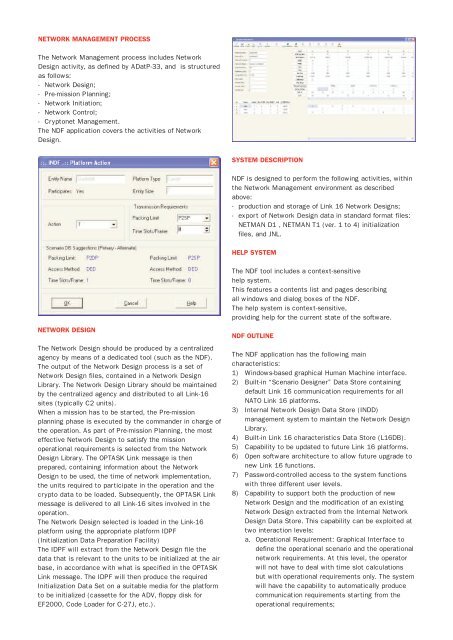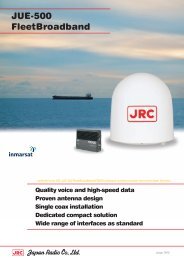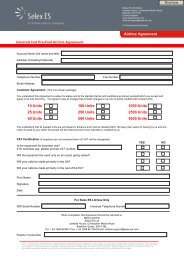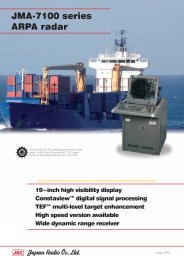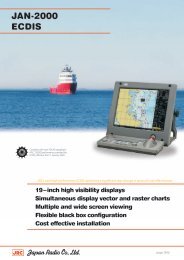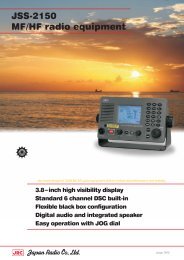NDF - Network Design Facility
NDF - Network Design Facility
NDF - Network Design Facility
You also want an ePaper? Increase the reach of your titles
YUMPU automatically turns print PDFs into web optimized ePapers that Google loves.
NETWORK MANAGEMENT PROCESS<br />
The <strong>Network</strong> Management process includes <strong>Network</strong><br />
<strong>Design</strong> activity, as defined by ADatP-33, and is structured<br />
as follows:<br />
- <strong>Network</strong> <strong>Design</strong>;<br />
- Pre-mission Planning;<br />
- <strong>Network</strong> Initiation;<br />
- <strong>Network</strong> Control;<br />
- Cryptonet Management.<br />
The <strong>NDF</strong> application covers the activities of <strong>Network</strong><br />
<strong>Design</strong>.<br />
NETWORK DESIGN<br />
The <strong>Network</strong> <strong>Design</strong> should be produced by a centralized<br />
agency by means of a dedicated tool (such as the <strong>NDF</strong>).<br />
The output of the <strong>Network</strong> <strong>Design</strong> process is a set of<br />
<strong>Network</strong> <strong>Design</strong> files, contained in a <strong>Network</strong> <strong>Design</strong><br />
Library. The <strong>Network</strong> <strong>Design</strong> Library should be maintained<br />
by the centralized agency and distributed to all Link-16<br />
sites (typically C2 units).<br />
When a mission has to be started, the Pre-mission<br />
planning phase is executed by the commander in charge of<br />
the operation. As part of Pre-mission Planning, the most<br />
effective <strong>Network</strong> <strong>Design</strong> to satisfy the mission<br />
operational requirements is selected from the <strong>Network</strong><br />
<strong>Design</strong> Library. The OPTASK Link message is then<br />
prepared, containing information about the <strong>Network</strong><br />
<strong>Design</strong> to be used, the time of network implementation,<br />
the units required to participate in the operation and the<br />
crypto data to be loaded. Subsequently, the OPTASK Link<br />
message is delivered to all Link-16 sites involved in the<br />
operation.<br />
The <strong>Network</strong> <strong>Design</strong> selected is loaded in the Link-16<br />
platform using the appropriate platform IDPF<br />
(Initialization Data Preparation <strong>Facility</strong>)<br />
The IDPF will extract from the <strong>Network</strong> <strong>Design</strong> file the<br />
data that is relevant to the units to be initialized at the air<br />
base, in accordance with what is specified in the OPTASK<br />
Link message. The IDPF will then produce the required<br />
Initialization Data Set on a suitable media for the platform<br />
to be initialized (cassette for the ADV , floppy disk for<br />
EF2000, Code Loader for C-27J, etc.).<br />
SYSTEM DESCRIPTION<br />
<strong>NDF</strong> is designed to perform the following activities, within<br />
the <strong>Network</strong> Management environment as described<br />
above:<br />
- production and storage of Link 16 <strong>Network</strong> <strong>Design</strong>s;<br />
- export of <strong>Network</strong> <strong>Design</strong> data in standard format files:<br />
NETMAN D1 , NETMAN T1 (ver. 1 to 4) initialization<br />
files, and JNL.<br />
HELP SYSTEM<br />
The <strong>NDF</strong> tool includes a context-sensitive<br />
help system.<br />
This features a contents list and pages describing<br />
all windows and dialog boxes of the <strong>NDF</strong>.<br />
The help system is context-sensitive,<br />
providing help for the current state of the software.<br />
<strong>NDF</strong> OUTLINE<br />
The <strong>NDF</strong> application has the following main<br />
characteristics:<br />
1) Windows-based graphical Human Machine interface.<br />
2) Built-in “Scenario <strong>Design</strong>er” Data Store containing<br />
default Link 16 communication requirements for all<br />
NATO Link 16 platforms.<br />
3) Internal <strong>Network</strong> <strong>Design</strong> Data Store (INDD)<br />
management system to maintain the <strong>Network</strong> <strong>Design</strong><br />
Library.<br />
4) Built-in Link 16 characteristics Data Store (L16DB).<br />
5) Capability to be updated to future Link 16 platforms.<br />
6) Open software architecture to allow future upgrade to<br />
new Link 16 functions.<br />
7) Password-controlled access to the system functions<br />
with three different user levels.<br />
8) Capability to support both the production of new<br />
<strong>Network</strong> <strong>Design</strong> and the modification of an existing<br />
<strong>Network</strong> <strong>Design</strong> extracted from the Internal <strong>Network</strong><br />
<strong>Design</strong> Data Store. This capability can be exploited at<br />
two interaction levels:<br />
a. Operational Requirement: Graphical Interface to<br />
define the operational scenario and the operational<br />
network requirements. At this level, the operator<br />
will not have to deal with time slot calculations<br />
but with operational requirements only. The system<br />
will have the capability to automatically produce<br />
communication requirements starting from the<br />
operational requirements;


